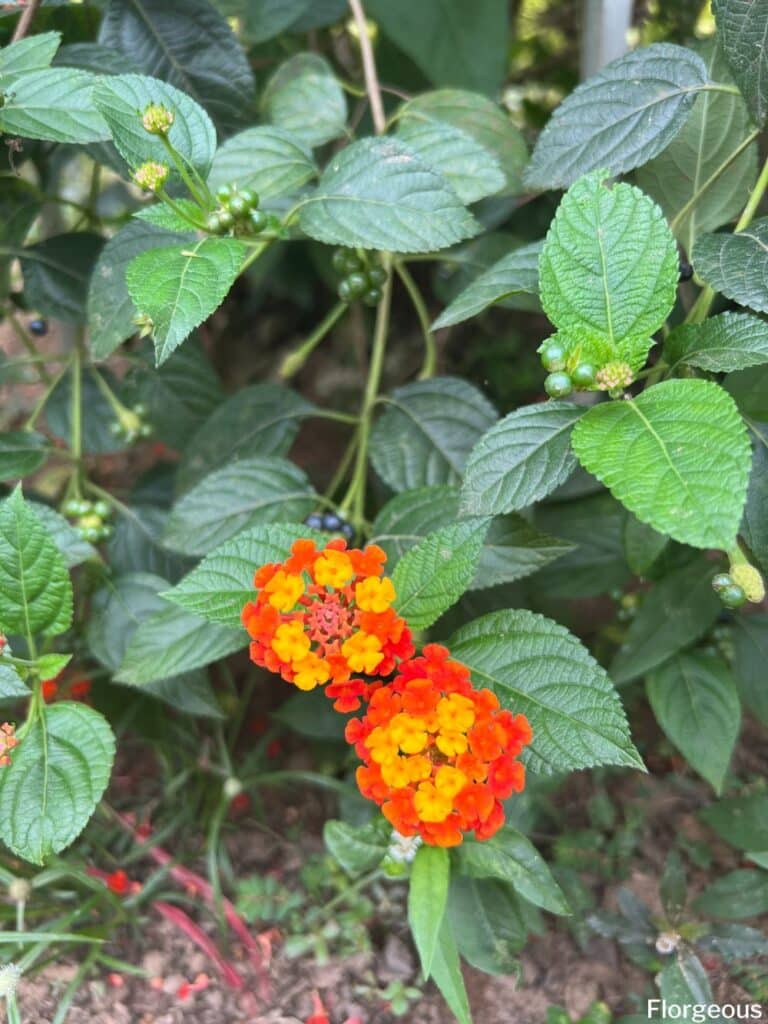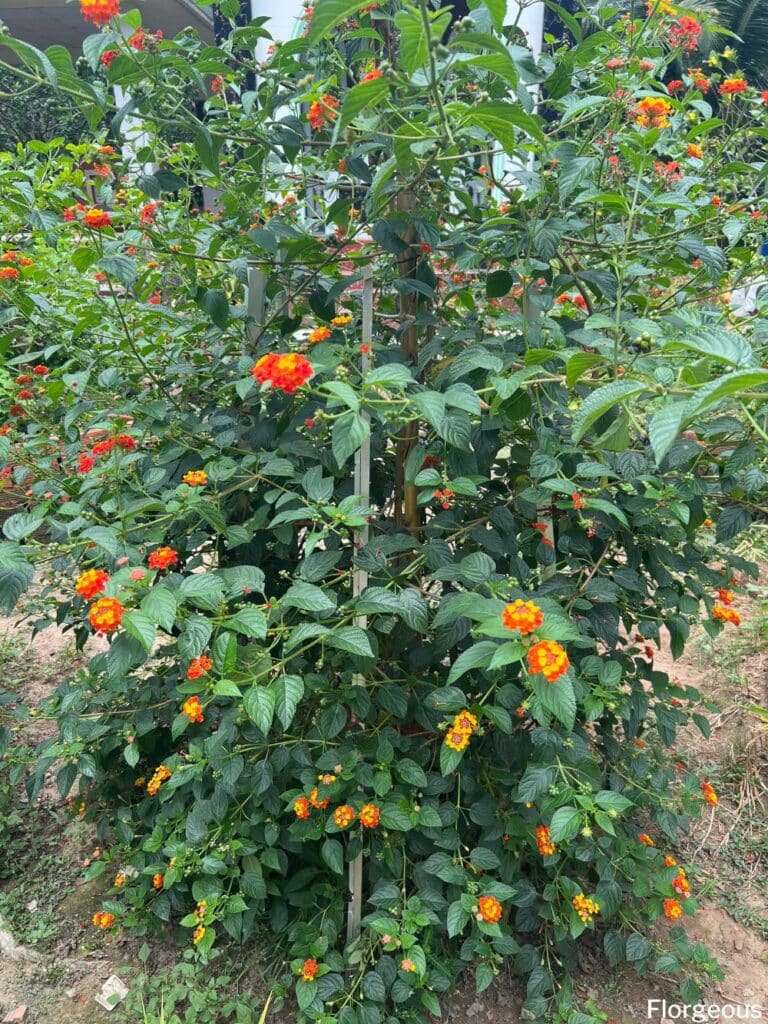Lantanas are beautiful flowers prized for their vibrant colors and long-lasting blooms.
They are generally low-maintenance and drought-resistant, making them ideal for gardeners who don’t have the time to care for high-maintenance plants.
However, not all lantanas are created equal. There are different types of lantanas, each with their own unique qualities that make them stand out from one another.
These colorful flowers with dark green foliage are certainly not one-size-fits-all – no matter what kind of garden you’re trying to grow, these flowering shrubs are sure to be right for you.
Can’t decide which varieties of lantana will suit your garden best? In this post, we’ll take a closer look at these flowering plants so you can find the lantana species that’s right for you.

What Exactly Are Lantana Flowers?
Lantana flowers belong to a genus of about 150 species of flowering plants native to Central and South America. These herbaceous perennials have a spreading shrub-like growth habit, and they can grow up to 6 feet in some cases.
There are various species of Lantana flowers, which we’ll give a quick overview of below.
Lantana camara is the most popular of the Lantana species. Commonly referred to as West Indian shrub verbena or Texas Lantana, along with calico bush, it is known for its bright and show-stopping colors, which range from orange, pink, red, and yellow. The plant prefers areas with full sun and is an excellent choice for garden borders and flowerbeds.
Lantana trifolia, on the other hand, is a low-growing shrub that’s commonly known as Texas lantana. It’s an excellent option for gardeners who prefer a smaller plant and is ideal for erosion control thanks to its ability to spread quickly.
Lantana horrida is also a small shrub-like plant that’s commonly found in tropical areas like the aforementioned Central and South America. This category of lantana varieties is unique as it produces flowers with stunning shades of violet, blue, and purple.
Another species of Lantana flower is Lantana involucrata. It’s a small, creeping plant that grows in South American and produces red or pink flowers and has medicinal properties.
Finally, Lantana urticoides is a hardy plant species that boasts dazzling yellow flowers and is known for creating flowers that are great at withstanding drought-like conditions.
Confused? Don’t worry – we’ll keep breaking down the many different types of lantana in this post so you can create some amazing lantana landscaping ideas.

What Are The Different Types of Lantana?
With so many different types of lantanas, you’re sure to find one that suits your taste and your garden’s needs. Whether you’re looking for a tall shrub or a low-growing ground cover, lantanas can provide the perfect solution.
With their drought resistance and long-lasting blooms, they’re an excellent addition to any garden.
Looking to grow lantanas? Here are some choices to consider.
Common Lantana (Lantana camara)
The common lantana is perhaps the most well-known lantana of them all. It’s a popular choice for gardeners because of its stunning colors and hardiness.
Common lantanas can grow up to six feet tall, making them a great choice for hedges. They bloom in a wide variety of colors such as yellow, red, pink, and orange, and are known to attract butterflies and hummingbirds.
Out of all the different types of lantana plants, Lantana camara is one of the most common. This lantana plant can grow in just about conditions, and there are numerous subspecies and cultivars that have been developed from these classic lantana plants.
Popcorn Lantana (Lantana trifolia)
The popcorn lantana gets its name from the shape of its flowers, which resemble popcorn. This type of lantana is smaller than the common lantana, usually only growing up to three feet tall. However, what it lacks in size, it makes up for in color variation.
Popcorn lantanas come in a range of colors from white to pink, yellow, orange, and red. Most notable, however, is the lavender popcorn lantana, which comes in a rich pale purple shade. Lavender popcorn lantana is perhaps one of the most popular types of lantana you’ll find.
Trailing Lantana (Lantana montevidensis)
If you’re looking for a lantana that trails beautifully over rock walls or hanging baskets, the trailing lantana (Lantana montevidensis) is the perfect choice. It has a low, spreading habit that can reach up to two feet in height and four feet in width.
As you might assume, the trailing lantana plant is known to produce flowers in a trailing growth pattern that is excellent for hanging baskets.
These trailing plants bloom in a soft purple color and are a great option for gardens where you want a softer, more delicate look.
Texas Lantana (Lantana urticoides)
As the name suggests, this type of lantana is commonly found in the state of Texas. It’s a hardy plant that’s known for its heat tolerance and drought resistance, making it an excellent choice for gardens with hot, dry climates. Texas lantanas have bright yellow and dark orange blooms that form in clusters on the top of the plant, creating a striking display.
Desert Lantana (Lantana achyranthifolia)
The desert lantana is a low-growing lantana that’s perfect for borders or as a ground cover. It’s an ideal choice for gardens in dry regions because it doesn’t require a lot of water to thrive. Desert lantanas have small, bright yellow flowers that form clusters at the end of the stem.
Wild Lantana (Lantana horrida)
The wild lantana is a shrubby plant that can reach five feet in height. It’s an ideal choice for gardens with a country or rustic theme because of its wild appearance. The plant produces pale yellow and orange colored flowers that bloom during summer and fall.
Buttonsage (Lantana involucrata)
The button sage lantana is named after its small, button-like flowers. It’s a great choice for gardeners who want a lantana that’s both robust and colorful. Buttonsage lantanas have bright pink and yellow flowers with a blooming season in the fall.
What Are Some Popular Lantana Cultivars?
Are you looking for the perfect addition to full sun flower beds – or perhaps a plant to grow as a perimeter planting around your vegetable garden? Look no further than the lantana cultivar.
This spreading shrub is not only easy to maintain, but it also comes in a variety of colors that can add a pop of brightness to your outdoor space.
Here are some unique types of lantana cultivars to consider growing.
Dallas Red Lantana
The Dallas Red Lantana is a stunning plant with bright, fiery red and yellow blooms. This plant is easy to maintain and is both heat and drought tolerant, making it perfect for those hot summer months. It is also known to attract hummingbirds, butterflies, and bees with its fragrant flower heads, making it an ideal addition to any garden that focuses on pollinator-friendly plants.
Confetti Lantana
If you’re looking for a cultivar with a mix of colors, the Confetti Lantana is an excellent option. This plant features vibrant clusters of red, yellow, and orange flowers that bloom from early summer to fall. Confetti Lantana is also heat-resistant and is perfect for gardens located in hot and sunny areas.
Patriot Rainbow
For those who prefer a more subdued color palette, the Patriot Rainbow Lantana is a fantastic option. With muted pink, yellow, and purple hues, this plant blooms all summer long and is perfect for adding some flair to your garden without overwhelming your other plants.
Lantana ‘Silver Mound’
While not a colorful option like the others, the Lantana ‘Silver Mound’ cultivar adds a unique texture to your garden. This plant has beautiful, silvery foliage and small white flowers that bloom from summer through fall.
Silver Mound lantana is also a small bush plant with a mounding growth habit, growing no more than 18 inches tall, making it an ideal option for those with limited garden space.
Irene
Irene Lantana is a particularly unique cultivar, thanks to its multicolored blooms. With hues ranging from pale pink to deep purple, this plant is sure to catch the eye of any passerby. The Irene Lantana blooms from summer through fall, and its flowers release a delicate citrusy scent.
Dove Wings
Another great option is Dove Wings, which are lantana varieties that are offshoots of the Patriot series of lantana varieties. These plants are known for their white blooms with yellow centers, along with the classic dark green leaves.
Lavender Swirl
As its name suggests, Lavender Swirl features two-tone lavender blooms and white hues that appear from spring to fall. This cultivar thrives in full sun, moist soil, and a regular fertilizing schedule. You can use Lavender Swirl as a bedding plant, container filler, or a backdrop in your borders. It’s also a great choice if you’re looking to attract butterflies, bees, and hummingbirds.
Lantana Lucky Lavender
For a more monochromatic look, you can opt for Lucky Lavender. This cultivar blooms with abundant clusters of lavender flowers that tend to intensify in color as they mature.
Lucky Lavender grows best in full sun or partial shade, and well-drained soil. It can add a pop of color to your garden beds, hanging baskets, or window boxes. Pruning it regularly can encourage bushier growth and more blooms.
New Gold Lantana
If you prefer warm and sunny colors, New Gold lantana might catch your fancy. This cultivar dons clusters of small golden-yellow flowers that emit a sweet fragrance. New Gold lantana is drought-tolerant, prefers full sun, and can adapt to various soil types, from sandy to clay. It makes a great accent plant in your garden beds, mixed containers, or foundation plantings.
Fruity Pebbles
Fruity Pebbles is a charming lantana cultivar with multi-colored blooms that resemble tiny pebbles in shades of pink, yellow, and orange. This cultivar is a dwarf form that reaches 18 inches tall and spreads up to two feet. It needs full sun exposure and well-draining soil to thrive. Fruity Pebbles can serve as a ground cover, border plant, or a spiller in your containers.
Lantana Radiation
Radiation might seem like a bold name for a plant, but it’s not unfounded for this lantana cultivar.
With fiery orange and red blooms that stand out against dark green lantana leaves, Radiation can add warmth and drama to your landscaping. This cultivar loves sun, heat, and dry soil, making it an ideal pick for xeriscaping. You can plant Radiation en masse, as a focal point, or a hedge.
Weeping Lantana
Weeping Lantana is a unique lantana cultivar that sports cascading branches of pink, purple, lavender, and white flowers that spill over walls, pots, and baskets. This cultivar thrives in full sun, well-draining soil, and occasional pruning to maintain its compact shape. Weeping Lantana can brighten up your hanging baskets, window boxes, and slope gardens.
Bandana Pink Lantana
This stunning lantana cultivar features bright pink flowers that really pop against their dark-green foliage. The Bandana Pink is a classic lantana that’s known for its long blooming season and resistance to diseases and pests.
It’s a bushy plant that can grow up to 24 inches tall and wide, making it a great choice for flower beds or hanging baskets. Its vibrant color makes it the perfect choice for brightening up any garden or patio.
Bandana Cherry Lantana
This lantana cultivar has beautiful red flowers that can also have yellow shades and are perfect for adding a pop of color to your garden. It’s a compact plant that grows to around 18-24 inches tall and wide, making it perfect for container gardening.
The Bandana Cherry has a long blooming season and is easy to care for, which makes it a great choice for novice gardeners or those who want to add some color to their garden without too much fuss.
Final words
When you’re selecting the type of lantana that will work best for your gardening space, consider factors such as soil type, sun exposure, and watering needs.
With these elements in mind, you can rest assured that the type of lantana you choose will thrive in your garden or patio – and add some undeniable beauty in the process.
Learn more about lantana flower symbolism to see why people love growing these plants.
See more: Overwatered Lantana: Identifying, Fixing, and Preventing Water Damage







